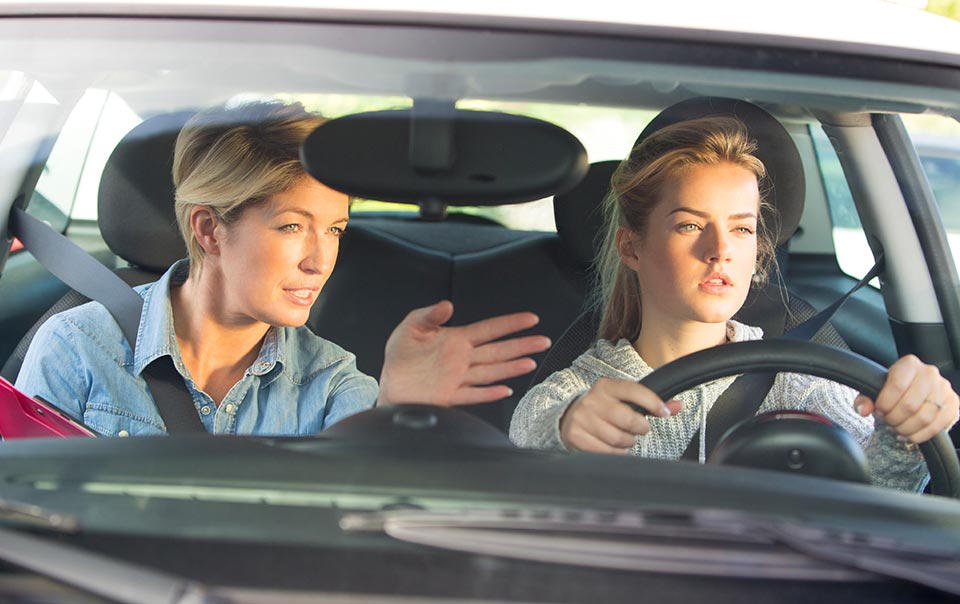Although you may have a driving agreement in place and your teen may be ready to get behind the wheel, she doesn’t have the years of experience that older drivers do. Even if your teen can be considered a responsible and conscientious driver, that doesn’t mean that other drivers on the road will act the same way.
A big part of driving successfully is knowing how to drive defensively. Here are 12 defensive driving skills your teen should know.
1. Make Safety a Priority
Safety should be non-negotiable. Remind your teen to always follow rules that will keep them safe, such as wearing a seatbelt, avoiding tailgating, and never passing in a no-passing zone. Explain to your teen that they should travel at least three to four seconds behind the driver in front of them to allow enough space to stop quickly if needed.
2. Avoid Distractions
Impress upon your teenager that taking his eyes off the road, even briefly, can result in an accident. Driving requires the driver’s full attention, so reaching for something in another part of the car, gazing out the side windows, or texting and driving are not wise choices.
3. Be Aware of Surroundings
While driving it’s vital to pay attention to the road ahead and other drivers who are in front of, beside or behind you. Teens should get into the practice of checking their mirrors frequently to keep tabs on what’s going on around them. Paying attention to the road ahead can help you realize if there’s something in the roadway – an animal, debris or traffic that’s come to a stop — and give you time to react.
4. Never Assume Another Driver Will Act or React in a Certain Way
Explain to your teen that other drivers on the road can be unpredictable and negligent. Whether they are distracted or driving recklessly, you cannever assume that another driver will act or react safely or in the manner you would. For example, according to The Barnes Firm, a car accident injury attorney in Oakland, “An example of negligent driving would be if someone behind the wheel failed to stop at a stop sign, causing them to strike another car in the intersection, and thus, injuring the other driver.”
By alerting your teen to these types of possibilities, he or she can learn to be on the lookout when approaching an intersection and understand that we can’t control how other people drive. Thiswill help to avoid collisions with reckless driversthat may result in severe injuries.
6. Follow the Speed Limit
Explain to your teen that speed limits are designed for the best driving conditions — not when the weather is bad or traffic is heavy. Your teen will have to learn to adjust her speed in different conditionsso that she can maintain control of the vehicle.
7. Yield If You’re Unsure
Teen drivers who aren’t sure if they have the right-of-way or not should yield to the other driver. They should also be prepared to yield — even if they know they have the right-of-way — if another driver doesn’t understand the rules of the road.
8. Don’t Race Stoplights
Tell your teen to slow down as they approach the intersection, especially if the light is yellow. Although it may seem like a fun challenge to make the light, some lights turn red almost instantly after yellow. If your teen is going too fast, he will run the red light.
9. Blinkers Are Your Friend
While some don’t utilize blinkers, other drivers often rely on the blinkers of other cars to alert them that something’s about to change. Make sure your teen realizes that it’s important to use blinkers routinely to cut down on possible confusion between her and other drivers on the road.
10. Don’t Engage With Rage
Almost everyone who drives will tell you that they’ve become at least a little angry at one time or another while driving. But it’s better to let certain incidents go, such as a driver cutting you off or tailgating you. Trying to engage with a driver who did something reckless can end badly — especially if you or the other driver are experiencing road rage. It’s better to ignore drivers with road rage and continue driving carefully.
11. Remember Blind Spots
Explain to your teen about a car’s blind spots and how when a driver hangs out there,it can be seemingly impossible to notice them without looking directly. This especially applies to large vehicles, such as 18-wheelers. If you can’t see the driver in his side mirror, he can’t see you, either. Make sure your teen knows all of his blind spots and is careful to avoid big vehicles with many blind spots on the highway.
12. Slow Down in Inclement Weather
When it’s foggy or raining, it’s critical to slow down. During rainy weather, the roads become slick and increase the time it will take you to brake. If you’re driving too fast or have your cruise control set, the car can end up hydroplaning and the driver can lose control. In foggy conditions, when a driver can’t see more than a few feet ahead, it’s important to drive more slowly to have more reaction time if you come upon something in the roadway suddenly.

